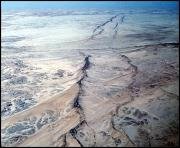Magmatism, rifting and continental breakup
The aim of this subproject is to read and interpret the magmatic “signal” of processes related to Gondwana breakup and dispersal in the Mesozoic. The diversity of southern Africa's rifted continental margins offers a globally unique chance for comparative studies from different parts of the margins system that experienced variable intensity, composition and duration of magmatism. By studying the composition of magmas produced, we can identify their sources and estimate the temperature and pressure conditions of formation. Combined with age and volume estimates, we can deduce magma flux rates for different parts of the developing margins and relate these to new geophysical and geologic constraints on style and rates of deformation, and on the regional margin architecture. Our work will address the following key questions: Where, when and how much heat and mass were delivered into and through the rifting continental lithosphere?
- What were the controlling factors that determined the location and the degree of mantle melting, how and why did these factors change along the margins and in time as the margin systems evolved from the rift to drift stages.
- What was the relative importance of shallow-mantle convection vs. deep-mantle plumes in driving and sustaining the breakup process?
- To what extent is the process controlled or influenced by pre-existing structures and properties of the continental lithosphere?
The separation of Gondwana fragments and the opening of the southern oceans was accompanied by a highly variable magmatic activity. In some parts of the rifting continents, magmatism was extremely intense and involved a tremendous input of mass and heat from the mantle into the crust and the surface environment. Elsewhere, rifting proceeded to completion with little or no accompanying magmatism. Not only are the volumes and rates of magmatism variable, but also the compositions of magma produced are very different from place to place in the rifting continent and from early to late stages of the process. If we understand how and why these differences exist, we will be a long way toward understanding the fundamental workings of the deep earth and its influence on the lithosphere and crust.


